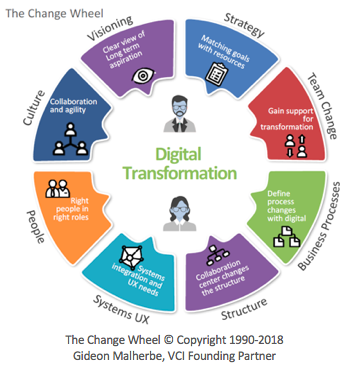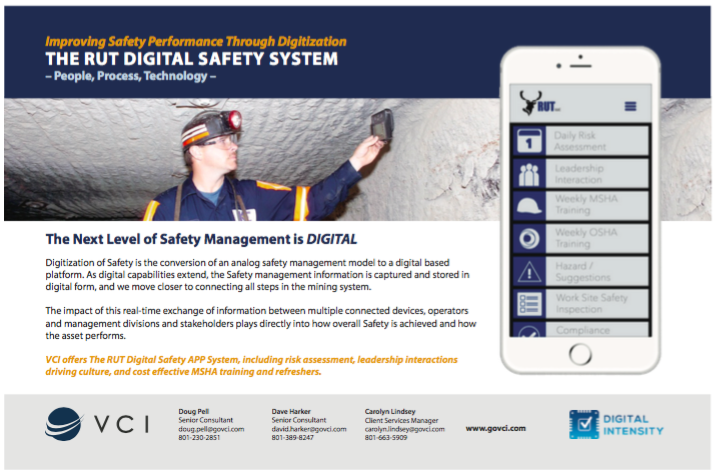By: Doug Pell, VCI Senior Consultant
Introduction
As I think back over my 20+ years as a health & safety professional, there were numerous activities, campaigns, efforts, etc. to make an impact in the health & safety of the organizations and employees I was fortunate to work with. Often, my focus was driven by the maturity of the organizations and teams I was engaged with at the time. Sometimes this involved basic short-term campaigns to raise awareness and/or engagement. Other times it was focused on driving long-term behavior and culture change. And there were times when it was a combination of the two. There were certainly high points and low points. The low points being times when leadership delegated safety to the department level and then wondered why results were not better. Or times when the only measurement was on employee injuries and more work was spent managing the injuries versus preventing the injuries. The high times were when leadership understood that health & safety was their responsibility just like any other part of running the business – when safety was viewed as a value and not just a priority, and when employee engagement drove the safety culture to new levels of maturity.
Regardless of the organization’s level of maturity, a couple things that made a big difference were leadership engagement and data. We always had plenty of data, but it was predominantly post injury or incident data which led to more broad-based campaigns versus very focused proactive campaigns. Leadership engagement was, and still is, a very fragile thing. Leaders come and go often. New leaders have a desire to make their own mark on the organization and what took years to build can be deconstructed in months.
One of my favorite safety career memories was deploying a process we called Six Sigma Safety. Working in a high speed, high volume manufacturing facility, we were experiencing many repetitive trauma injuries and/or illnesses. As much as we tried to get employees to “report aches and pains,” we were only collecting very basic data, usually when treatment was required. We knew our existing data limited our interventions to broad-based solutions and were not targeted to specific tasks that employees were performing. We knew we had to do better, and we did. Fortunately, we had a leader that bought into the process and owned it from day 1.
After a lot of hard work, improved data collection and analysis, detailed action plans, and monthly report out sessions, we were seeing a difference. Our injury performance dropped from an average of 12 recordable injuries a year to 0-2 injuries per year. Employee feedback was very positive, and the number of aches and pains complaints were greatly reduced as well. I recall sitting in my office one day, looking at the numerous binders holding all the data and analysis, copies of overhead transparencies, detailed action plans and asking myself, “How are we going to sustain this going forward?” We were living in the analog age, we had no discussions on how to transform from an analog operation to a digital organization, a team of only 2 professionals, and we were now expected to sustain and improve upon the impressive gains we had made.
What is an Effective Safety Management System
The National Safety Council defines an effective Safety Management System as one that:
- Reduces the risk of workplace incidents, injuries and fatalities through data-driven measurements and improvements
- Involves engaging people and working in partnership to make safety a shared responsibility, recognizing the value of cross-level teamwork
- Is organized and structured to ensure organizations are able to achieve and maintain high standards of safety performance
- Is proactive, preventive and integrated into the culture of your organization
They go on to state the 5 characteristics that are representative of a “world class” safety management system to include:
- Leadership – The management of an organization must lead by example to help drive employee engagement
- Integrated systems approach – Integrating safety processes into all business functions and structures can result in safety becoming embedded in how an organization does business
- Performance measurement – Both leading and lagging indicators must be used to promote and monitor continuous improvement of the management system
- Alignment to core organizational initiatives – Through visioning, strategic planning and budgeting, safety can become aligned with all other objectives, strategies and values in an organization
- Corporate citizenship and off-the-job safety – Through initiatives, world-class organizations extend their safety efforts to both the community and employees outside of work
These characteristics have stood the test of time. Yet, why do many organizations find it difficult to turn these characteristics into living, sustainable actions and results? With each of the items above, you could place in front the phrase “Lack of…” to answer this question. However, one other item that should be added is time. As with any analog, paper-based system, it comes down to time:
- time to manage and process the paperwork
- time to manually fill out incident reports and time to enter into an electronic database
- time to sift through mounds of reports and data and conduct a meaningful analysis
- time to print off and distribute assessment or inspection forms
- time to document observations or inspections, make copies and return to the safety department

The Shift from Analog to Digital

A simple online search will lead you to many providers of digital safety solutions with an ease to purchase and download the systems, it can be enticing to quickly do so. A word of caution paraphrased from the movie Field of Dreams” “If you build it, they will come,” does not apply here. Think of all the apps you have on your smartphone, tablet and computers. Are you using 100% of them? Are they doing for you what you expected when you downloaded them (or worse yet, paid for them)? Safe to say, the ones you use regularly either have a process around using them, or they simply provide you enjoyment. The same is true for digital safety. Start with an overall strategy and, referring back to the NSC five characteristics of a world-class safety management system, ensure you take an integrated systems approach and the strategy is aligned with other organizational initiatives.
A basic process to follow to ensure an integrated approach and alignment involves the following 6 steps:

- Digital Intensity Assessment – understand your starting point and what your needs are based on People, Process & Technology
- Develop a Digital Strategy – are you wanting a system to address all things safety or simply focus on certain aspects of your safety management system?
- Opportunity Assessments – assess the opportunities and solution space
- 3 Horizons Digital Roadmap – remember the old saying: “If you don’t know where you’re going, any road will get you there” applies here – define where you want the organization to be in short, intermediate, and long-term time frames
- Emergent Need to Redefine – as the organization progresses down the roadmap it is OK to pause at defined intervals and ask if the path is still the best path – if not, adjust and carry on
- Input into Next Strategic Leap – the process should never be a “one and done” approach – plan for the next iteration of the overall digital strategy
Although a digital safety transformation may not be to the same scale as an organization-wide transformation, following the same full process for transformation will increase chances for success.
So why shift from an analog safety management system to a digital system?
The benefits are many and typically center around increased engagement, time savings, and improved visibility and use of data. Common reasons to undertake a digital safety transformation are:
- Increased level of engagement at all levels – let’s be honest, if something is easier to do, people are more prone to be involved
- the speed in which you can complete tasks
- the visibility of real-time and improved analytics – leads to more proactive measures versus reactive measures
- improved accountability – in real time you can visibly see what actions are being completed by whom and when – no more week end or month end reports highlighting good and bad that occurred up to four weeks prior – it’s real time
- able to witness live updates across multiple sites
- use the system to edit and change things at the touch of a button – attributes that would not be possible just using paper
- the hours and hours of saved time and resources to manage all things safety

The VCI Offering
VCI offers the RUT Digital Safety System – a customizable digital safety system with several current standard modules.
- Risk Management Field Control Verification
- Fatal Risk Management Field Verification
- Simple and Critical Risk Assessment
- Vehicle / Equipment Pre-Operation Check
- Training
Each of these modules are developed with your organization’s existing information so when employees are using the system they see your information and are familiar with it. This is not a canned system. An organization can purchase and install one or all of the modules, and if a module doesn’t exist today we can work with you to design and build the perfect module for your needs.
Below is an example of what a risk assessment module could look like for an end-user.

The ease of use and ability to use existing technology will drive engagement at all levels of the organization. Additional functionality, shown below, provides real-time data/information to allow improved proactive action and accountability for employee engagement at all levels of the organization.

Beyond these incredibly useful features, VCI assists in the development of your management operating system to ensure the digital safety system is widely and deeply embedded within your organization versus it just being another tool that someone can choose to use if they desire.
Further, the VCI team is fully prepared to work with your organization in performing a digital intensity assessment, creation of the digital strategy, roadmap development and program management.
Conclusion
If your organization doesn’t have a strategy for digital transformation, the time is now, or your competitors will quickly pass you. If your safety management system is still in the analog phase, the time is now for digital transformation. Not only will you see improved levels of engagement and significant time savings in executing work, you will be driving your company culture closer to safety excellence and transforming your workplace into the truly healthy & safe environment that your employees deserve.




